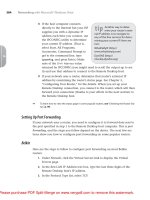ANALOG BEHAVIORAL MODELING WITH THE VERILOG-A LANGUAGE- P9
Bạn đang xem bản rút gọn của tài liệu. Xem và tải ngay bản đầy đủ của tài liệu tại đây (471.5 KB, 14 trang )
Using the Explorer IDE
After a plot has been selected, you can change its properties via the Plot Properties
dialog accessible from the right-mouse button within the plot window. The Plot Prop-
erties dialog allows you to set generic, axis, and signal attributes.
Generic plot attributes include the plot type as well as display of titles and/or subti-
tles.
Axis properties of the plot allow you to set the axis styles for both the X- and Y-axis,
including labels and tic-mark styles.
Verilog-A Explorer IDE
197
Verilog-A Explorer IDE
Signal properties allow you to edit the description of the signals displayed in the leg-
end box, as well as the data format and drawing attributes.
D.3.2 Creating a New Designs
Starting a new design follows essentially the same procedure as previously outlined,
but with the addition to creating a new circuit and/or Verilog-A file(s). From the main
Explorer menu, select File->New, which raises the following dialog box:
If you select a circuit file, the workspace will be cleared of any open files. If you
select a Verilog-A file, it is assumed that it is associated with any existing circuit
design open within the workspace. In both cases, a new file is created and initialized
with a template file of the appropriate type. If you prefer your own template files,
change the path of the template via the respective Editor Properties dialog accessible
via the right mouse button.
198
Verilog-A HDL
Appendix E
Spice Quick Reference
E.1 Introduction
Spice is a general-purpose circuit simulation program for nonlinear DC, nonlinear
transient, and linear AC analysis. Originating from the University of California at
Berkeley, is by far the best known and most widely used circuit simulator. It is availa-
ble in for a wide variety of computer platforms, in both commercial and proprietary
derivatives of the original version.
Newer versions of Spice offer many extensions, but the input format for circuit
descriptions reflect the original batch-oriented program architecture. This appendix
overviews the Spice input format, or netlist files including the fundamental types and
analyses supported. Omitted for brevity are details regarding semiconductor device
models and the various Spice options.
Spice Quick Reference
199
Spice Quick Reference
E.2 Circuit Netlist Description
The netlist (also referred to as the input deck) consists of element lines which
describes both the circuit topology and element values and control lines which
describe analyses to be performed for Spice. The first card in the input deck must be a
title card, and the last card must be the .END
control line. The order of the remaining
element and control lines is arbitrary.
The input format is free format. Fields on an element or control line are separated by
one or more blanks, commas, equal (=) sign, or a left or right parenthesis. A element
or control line may be continued by placing a (+) in column 1 on the following line.
Spice will continue reading beginning with column 2.
Name fields must begin with a letter [a–z] and cannot contain any delimeters. Names
within Spice netlists are considered case-insensitive
1
. An integer or a floating point
number can be followed by one of the following scale factors:
G =
1.0e9
MEG =
1.0e6
K =
1.0e3
MIL = 25.4e-4
M = 1.0e-3
U = 1.0e-6
N = l.0e-9
P = 1.0e-12
1. Names in Verilog are case-sensitive requiring a certain level of awareness for modelers in
developing Verilog-A models that are case-independent for use within Spice netlists.
200
Verilog-A HDL
Spice Quick Reference
201
E.3 Components
Letters immediately following a scale factor are ignored.
Each element in the circuit is specified by an element line that contains the element
name, the circuit nodes to which the element is connected, and the values of the
parameters that determine the electrical characteristics of the element.
The first letter of the element name specifies the element type. The nodes following
the element name must be non-negative integers but need not be numbered sequen-
tially and where node 0 is the ground or reference node.
A control line within the input deck is specified by a line containing a (.) in the first
column, followed by the name of the control and its parameters. Examples include all
the analysis cards (described later) and the . END control line signifying the end of
input.
Circuits in Spice may contain resistors, capacitors, inductors, mutual inductors, inde-
pendent voltage and current sources, dependent sources, transmission lines and the
four most common semiconductor devices: diodes, bipolar junction transistors, junc-
tion field-effect transistors, and mosfets. The general input formats for each of these
types is described below. Arguments specified within [] are optional.
E.3.1 Elements
Passive elements in Spice such as resistors (R), capacitors (
C
), and inductors (
L
):
Rxxxxxxx
NP NN value
Cxxxxxxx
NP NN value
Lxxxxxxx
NP NN value
Components









